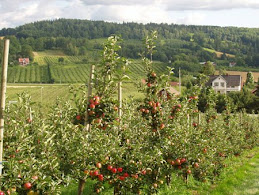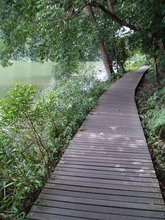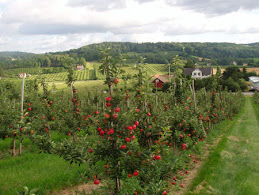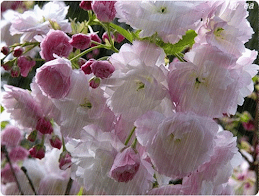By Lin Yangchen, linyc@sph.com.sg, The Straits Times, Saturday, 12 March 2016

PHOTO: Trees provide shade and cool the air when water evaporates from their leaves. Having trees behind a house might save money on air-conditioning bills. This has to do with the way plants cool the air when water evaporates from their leaves. With climate change already bringing higher temperatures and more extreme weather events, the importance of greenery is set to increase.
Photo: The Straits Times
https://blogger.googleusercontent.com/img/b/R29vZ2xl/AVvXsEhhwIFUkjR_AEXUAscCabne7fhghyCdgdhkJ-b4ShAqWX04cQRZvA0dCuVQG6qvQS4IGRnjVg0ydWYpb16BzCgBKeV9QAUBz9RSmt32X7yahB1ETJUknsHBvEJQ_r-RUgpyoD_EajVMyws/s1600/20160216-st-trees.jpg
http://news.asiaone.com/sites/default/files/styles/w848/public/original_images/Feb2016/20160216-st-trees.jpg?itok=EHNL3rM7×tamp=1455594379
http://news.asiaone.com/news/asian-opinions/cross-island-line-debate-misses-elephant-room
http://www.veryfatoldman.blogspot.sg/2016/02/cross-island-line-debate-misses.html
They provide shade and cool the air when water evaporates from their leaves.
Did you know that the patch of trees behind your house might save you money on air-conditioning bills?
This has to do with the way plants cool the air when water evaporates from their leaves. With climate change already bringing higher temperatures and more extreme weather events, the importance of greenery is set to increase.
"We are in a climate where every degree counts in terms of human comfort," said Associate Professor Matthias Roth of the department of geography at the National University of Singapore (NUS).
This is especially so in a densely built city like Singapore, where concrete surfaces absorb heat during the day and the "canyons" of closely packed buildings prevent it from escaping at night.
The initial renderings of WOHA Architects' Park Royal Hotel in Singapore showed a building almost completely overrun with gardens, water features and green pathways - and now we're excited to say that the project is complete! The lush urban oasis features cascading planter terraces and waterfalls, creating an almost otherworldly botanical microcosm in the midst of busy Singapore.
Posted by Parkroyal Singapore WOHA Architects
https://blogger.googleusercontent.com/img/b/R29vZ2xl/AVvXsEj06lYI30ou8j_UcPzdWyIdoRDBTK6RZ8u7Eiz6LM2zEcE66PDnF46NOpbw22RdBhgKxRec3Ex6FYIE5mTllkEeh_pa5_dlK3rmVXizDR9mVYw-2DUChz0JzjhKLMEk8HEyBYBpkxHVPmo/s1600/Parkroyal-Singapore-WOHA-Architects-9.jpg
http://assets.inhabitat.com/wp-content/blogs.dir/1/files/2013/04/Parkroyal-Singapore-WOHA-Architects-9.jpg
http://inhabitat.com/park-royal-tower-wohas-stunning-vertical-urban-park-opens-in-singapore/parkroyal-singapore-woha-architects-10/
This is known as the urban heat island effect and was the subject of a recent study by Prof Roth in collaboration with his master's student, Mr Reuben Li.
They deployed about 40 temperature and humidity sensors all over Singapore, monitoring hourly changes in different environments over about three years.
The study found that rural areas with few buildings, like Lim Chu Kang, were about 3 deg C cooler at night than urban areas such as Orchard Road. This is because a flat and open rural area allows heat to escape easily at night.
Trees are a beautiful part of our lives. From striking individual trees that are of historic significance or are simply large and majestic, to a grove of trees in a city park, trees enrich our lives by simply being there. Trees are not just a key to the natural ecosystem --trees are an essential part of community life.
Posted by IKEA Twin Cities on Friday, September 30, 2011 at 6:00 AM, 10 Reasons to Plant a Tree
https://blogger.googleusercontent.com/img/b/R29vZ2xl/AVvXsEiI9FHQzshqjtEFhyYHJWMhzOuHODRkrGPaaa8hh1HSTqjAoCZ93wL3xXYfy9MhAigV4lBvZHMfjmwowFGFMRf3LItz2NmrEWorr5AYGLFNfyPhS5zCz5NH3I-tkQdkeI195V3UkdMvHxA/s1600/PE208938.jpg
https://blogger.googleusercontent.com/img/b/R29vZ2xl/AVvXsEi2VJUqpDG6gsCSsfkUkNxZcH2e8kYsW9WORiYeR9lTM5Lfzi4nl_h4zdlEMroSCQXDvIxOTkQ1AlPkrjzVsCssML7q3Hp55CXDWfP4hhj_VgeVXZFgSTeR37bRkzJ-BGi7SsOJ-kY0X_FJ/s1600/PE208938.jpg
http://ikeatwincitiesmn.blogspot.sg/2011_09_01_archive.html
If the night is clear and calm, the rural area can be up to 7 deg C cooler as there are no clouds to prevent heat from escaping into space, and no wind blowing in warmer air from the city.
In the day, however, rural areas are as warm as urban areas, the researchers found. This is where having tall trees can make a difference.
The temperature sensors showed that at midday, forested areas are about 1.5 deg C cooler on average than urban areas. This is because trees provide shade as well as evaporative cooling.
Posted by Just Holes, Inc on 17 August 2012
https://blogger.googleusercontent.com/img/b/R29vZ2xl/AVvXsEhm63IFmGUVO_IZvTcuPu5vO0sf2JoCP9ahqggBDo4_fkeqwlIo4u6sAwIzCOJBZ4_b7TS9u74Eklmi0BOwnHJv69r8sDmATSmrRAjFeyK5ks5Tmgv3YTuPgYTAwClijq6-yr6NJEZ5yQA/s1600/shadetree.jpg
https://justholes.files.wordpress.com/2012/08/shadetree.jpg
https://justholes.wordpress.com/2012/08/17/how-to-save/
Even a small park in the city can have a cooling effect. An example is Telok Kurau Park, a rectangular plot measuring 187m by 97m with large shady trees, in the midst of a sprawling estate of low-rise housing.
A study by Prof Roth's honours student, Ms Khoo Yuan Ling, in 2004 found that on a clear and calm night, the park can be up to 2 deg C cooler than the surrounding area.
She also found that the cooling effect can be felt beyond the park boundary up to a distance roughly equal to its width. This is known as the edge effect.
Posted by Fox2006, nudiarist - The Pagan Witch
https://blogger.googleusercontent.com/img/b/R29vZ2xl/AVvXsEisy1HWDo17ba9_LPfdyz3vBrFPmWZBFsS2G2K0UJoL2dJcpkul2R2PXkh31NUOL4j_gEZ8I5A1Oplf7AeH-wwfDAJeBUd8xForB5fpJD0kp1HgYei6_l0VFGi2M6jkwr4Dc7BFT3r57-k/s1600/tumblr_n6e0k9Lg6D1qzt4a5o1_1280-1.jpg
http://40.media.tumblr.com/72c7408417a2c9f97a956884eaa5ee57/tumblr_n6e0k9Lg6D1qzt4a5o1_1280.jpg
http://mnm2.tumblr.com/post/87294067724
Said Prof Roth: "If you remove the pocket of green area, you remove the edge effect as well." The result? Increased discomfort and higher air-conditioning bills as people fight the heat by blasting their air-conditioning.
The Centre for Climate Research Singapore has projected an increase in surface temperature of 1.4 to 4.6 deg C across the country by the end of the century. While global warming is impossible for Singapore to control on its own, it still has a role to play.

Picture posted by wolf-66 - nude lady in the woods - seems nature meets fantasy. I love this pic. - Wolf
https://blogger.googleusercontent.com/img/b/R29vZ2xl/AVvXsEgtaMz5hOOzn11aAfwSDyTH1t3mwtj0cxjFLkOUQu1YkxUSTSaghkZTRbI6_OA6G_OQD7rSR-N-gBbmRI-7RZiWbPajEz9oCfL84_cCImtiZwIvO9BuXTCULG3lIPorK0xRRJbBGgOikLE/s1600/tumblr_ndugtlzCLu1u0jwzao1_1280-1.jpg
http://41.media.tumblr.com/555bc1bbc1c41a502a3e7866efbd64b3/tumblr_ndugtlzCLu1u0jwzao1_1280.jpg
http://baretracker.tumblr.com/post/113721736537/pegeha-wolf-66-nude-lady-in-the-woods-seemes
"What we can do locally is to try to mitigate the heat island effect," said Prof Roth.
The Singapore Government has worked hard to preserve greenery in the country, which ranks among South-east Asia's foremost economic powerhouses. Almost half of the island is green. The total area of greenery in Singapore increased from 35.7 to 46.5 per cent from 1986 to 2007, according to a report by the National Parks Board.
Picture posted by Blanca Portillo on 21 October 2014
https://blogger.googleusercontent.com/img/b/R29vZ2xl/AVvXsEg25HHFnXSZUveDz0q3WlppPm2JxQfNAAjauQWfJAMS-8xBc_Ih2zBQlyFNqDanhMAbEzJ5fb1xBfjScvxSaBvpYdRBoGFq8_1m17LOhpSSvTz-bIxO2KTb_FXuLR776wVbovQIn_mkjuI/s1600/Dutch-Colonial-with-Shady-Trees.jpg
https://blogger.googleusercontent.com/img/b/R29vZ2xl/AVvXsEi52wLyw5XoQliuRrlBQgbdBq5x6XozVy90qbXQXhtBYFlvJy0Xl-DkAwFY3879g3EbqAQcCfalQeQrUzf6sTzEtB6-YbISVrOl6x_23GFqAYD3P8qe7suULMqpQetLl_YarY_dsgyBuPE/s1600/Dutch-Colonial-with-Shady-Trees.jpg
http://coronariversideproperties.blogspot.sg/2014/10/gardening-7-of-fastest-growing-shade.html
The Urban Redevelopment Authority (URA) says that 9 per cent of Singapore's land has been set aside for parks and nature reserves, and 19 per cent for defence. A large proportion of the land for defence use is wooded.
URA also has policies in place to ensure that greenery and development go hand in hand.
"In all new regional growth centres, it is now mandatory for developers to replace 100 per cent of the site area they displaced on their new buildings in the form of greenery and communal spaces," said a URA spokesman.
Photo: Courtesy of Vo Trong Nghia Architects
https://blogger.googleusercontent.com/img/b/R29vZ2xl/AVvXsEh7QIAN7OaXec2SJbJ8rQnckDfgBM19Yk_H05xhwH4hGUxMwUKNYdaYT5w_p1JDGvzCnT5v2cvnahYiT1uIYUpYGmE1sgoOCsQ6uJDFr0o5R9CuJkUWmY5GQoFHJfe3HvqQRUKiTRI86jE/s1600/5-remarkable-buildings-that-use-trees-as-design-element-05.jpg
http://media.architecturaldigest.com/photos/564f99fe53d639997adbc0ab/master/w_806/5-remarkable-buildings-that-use-trees-as-design-element-05.jpg
http://www.architecturaldigest.com/story/5-remarkable-buildings-that-use-trees-as-design-element
Mr Kavickumar Muruganathan, head of eco-certifications and lead environmental engineer at the Singapore Environment Council, pointed out that greenery serves many purposes. Besides cooling the air and being home to wildlife, it relaxes the mind and acts as a natural noise barrier.
"It even acts as an effective flood alleviation mechanism," he added, citing the ability of vegetation to retain water.
This article was first published on March 11, 2016.
Get a copy of The Straits Times or go to straitstimes.com for more stories.

PHOTO: The giant forest trees in the Bukit Timah and Central Catchment nature reserves.
Greenery serves many purposes. Besides cooling the air and being home to wildlife, it relaxes the mind and acts as a natural noise barrier.
"It even acts as an effective flood alleviation mechanism," said Mr Kavickumar Muruganathan, head of eco-certifications and lead environmental engineer at the Singapore Environment Council, citing the ability of vegetation to retain water.
Posted by Audrey Tan, Published on 14 February 2016 at 5:00 am SGT
PHOTO: CHUA EE KIAM
https://blogger.googleusercontent.com/img/b/R29vZ2xl/AVvXsEiBTWHYnNdD50THCXVmpQj2eGOotBqXtmhaQM_uruyQR_C7QE67gJsClXJ2xk5qOifNhA-wFKailoNNEpPriCc5fTjU6pwFF8_NNUH8Err6VOlyNludI5TBlmAIo4WWSsumFPg8xuaobdg/s1600/print1405.jpg
http://www.straitstimes.com/sites/default/files/styles/large/public/articles/2016/02/14/print1405.jpg?itok=Bn-uIbfj
http://www.straitstimes.com/singapore/what-does-moderate-impact-mean
http://www.veryfatoldman.blogspot.sg/2016/02/cross-island-line-debate-misses.html
Reference
- https://blogger.googleusercontent.com/img/b/R29vZ2xl/AVvXsEhhwIFUkjR_AEXUAscCabne7fhghyCdgdhkJ-b4ShAqWX04cQRZvA0dCuVQG6qvQS4IGRnjVg0ydWYpb16BzCgBKeV9QAUBz9RSmt32X7yahB1ETJUknsHBvEJQ_r-RUgpyoD_EajVMyws/s1600/20160216-st-trees.jpg
- http://news.asiaone.com/sites/default/files/styles/w848/public/original_images/Feb2016/20160216-st-trees.jpg?itok=EHNL3rM7×tamp=1455594379
- http://news.asiaone.com/news/asian-opinions/cross-island-line-debate-misses-elephant-room
- http://www.veryfatoldman.blogspot.sg/2016/02/cross-island-line-debate-misses.html
- https://blogger.googleusercontent.com/img/b/R29vZ2xl/AVvXsEj06lYI30ou8j_UcPzdWyIdoRDBTK6RZ8u7Eiz6LM2zEcE66PDnF46NOpbw22RdBhgKxRec3Ex6FYIE5mTllkEeh_pa5_dlK3rmVXizDR9mVYw-2DUChz0JzjhKLMEk8HEyBYBpkxHVPmo/s1600/Parkroyal-Singapore-WOHA-Architects-9.jpg
- http://assets.inhabitat.com/wp-content/blogs.dir/1/files/2013/04/Parkroyal-Singapore-WOHA-Architects-9.jpg
- http://inhabitat.com/park-royal-tower-wohas-stunning-vertical-urban-park-opens-in-singapore/parkroyal-singapore-woha-architects-10/
- https://blogger.googleusercontent.com/img/b/R29vZ2xl/AVvXsEiI9FHQzshqjtEFhyYHJWMhzOuHODRkrGPaaa8hh1HSTqjAoCZ93wL3xXYfy9MhAigV4lBvZHMfjmwowFGFMRf3LItz2NmrEWorr5AYGLFNfyPhS5zCz5NH3I-tkQdkeI195V3UkdMvHxA/s1600/PE208938.jpg
- https://blogger.googleusercontent.com/img/b/R29vZ2xl/AVvXsEi2VJUqpDG6gsCSsfkUkNxZcH2e8kYsW9WORiYeR9lTM5Lfzi4nl_h4zdlEMroSCQXDvIxOTkQ1AlPkrjzVsCssML7q3Hp55CXDWfP4hhj_VgeVXZFgSTeR37bRkzJ-BGi7SsOJ-kY0X_FJ/s1600/PE208938.jpg
- http://ikeatwincitiesmn.blogspot.sg/2011_09_01_archive.html
- https://blogger.googleusercontent.com/img/b/R29vZ2xl/AVvXsEhm63IFmGUVO_IZvTcuPu5vO0sf2JoCP9ahqggBDo4_fkeqwlIo4u6sAwIzCOJBZ4_b7TS9u74Eklmi0BOwnHJv69r8sDmATSmrRAjFeyK5ks5Tmgv3YTuPgYTAwClijq6-yr6NJEZ5yQA/s1600/shadetree.jpg
- https://justholes.files.wordpress.com/2012/08/shadetree.jpg
- https://justholes.wordpress.com/2012/08/17/how-to-save/
- https://blogger.googleusercontent.com/img/b/R29vZ2xl/AVvXsEisy1HWDo17ba9_LPfdyz3vBrFPmWZBFsS2G2K0UJoL2dJcpkul2R2PXkh31NUOL4j_gEZ8I5A1Oplf7AeH-wwfDAJeBUd8xForB5fpJD0kp1HgYei6_l0VFGi2M6jkwr4Dc7BFT3r57-k/s1600/tumblr_n6e0k9Lg6D1qzt4a5o1_1280-1.jpg
- http://40.media.tumblr.com/72c7408417a2c9f97a956884eaa5ee57/tumblr_n6e0k9Lg6D1qzt4a5o1_1280.jpg
- http://mnm2.tumblr.com/post/87294067724
- https://blogger.googleusercontent.com/img/b/R29vZ2xl/AVvXsEgtaMz5hOOzn11aAfwSDyTH1t3mwtj0cxjFLkOUQu1YkxUSTSaghkZTRbI6_OA6G_OQD7rSR-N-gBbmRI-7RZiWbPajEz9oCfL84_cCImtiZwIvO9BuXTCULG3lIPorK0xRRJbBGgOikLE/s1600/tumblr_ndugtlzCLu1u0jwzao1_1280-1.jpg
- http://41.media.tumblr.com/555bc1bbc1c41a502a3e7866efbd64b3/tumblr_ndugtlzCLu1u0jwzao1_1280.jpg
- http://baretracker.tumblr.com/post/113721736537/pegeha-wolf-66-nude-lady-in-the-woods-seemes
- https://blogger.googleusercontent.com/img/b/R29vZ2xl/AVvXsEg25HHFnXSZUveDz0q3WlppPm2JxQfNAAjauQWfJAMS-8xBc_Ih2zBQlyFNqDanhMAbEzJ5fb1xBfjScvxSaBvpYdRBoGFq8_1m17LOhpSSvTz-bIxO2KTb_FXuLR776wVbovQIn_mkjuI/s1600/Dutch-Colonial-with-Shady-Trees.jpg
- https://blogger.googleusercontent.com/img/b/R29vZ2xl/AVvXsEi52wLyw5XoQliuRrlBQgbdBq5x6XozVy90qbXQXhtBYFlvJy0Xl-DkAwFY3879g3EbqAQcCfalQeQrUzf6sTzEtB6-YbISVrOl6x_23GFqAYD3P8qe7suULMqpQetLl_YarY_dsgyBuPE/s1600/Dutch-Colonial-with-Shady-Trees.jpg
- http://coronariversideproperties.blogspot.sg/2014/10/gardening-7-of-fastest-growing-shade.html
- https://blogger.googleusercontent.com/img/b/R29vZ2xl/AVvXsEh7QIAN7OaXec2SJbJ8rQnckDfgBM19Yk_H05xhwH4hGUxMwUKNYdaYT5w_p1JDGvzCnT5v2cvnahYiT1uIYUpYGmE1sgoOCsQ6uJDFr0o5R9CuJkUWmY5GQoFHJfe3HvqQRUKiTRI86jE/s1600/5-remarkable-buildings-that-use-trees-as-design-element-05.jpg
- http://media.architecturaldigest.com/photos/564f99fe53d639997adbc0ab/master/w_806/5-remarkable-buildings-that-use-trees-as-design-element-05.jpg
- http://www.architecturaldigest.com/story/5-remarkable-buildings-that-use-trees-as-design-element
- https://blogger.googleusercontent.com/img/b/R29vZ2xl/AVvXsEiBTWHYnNdD50THCXVmpQj2eGOotBqXtmhaQM_uruyQR_C7QE67gJsClXJ2xk5qOifNhA-wFKailoNNEpPriCc5fTjU6pwFF8_NNUH8Err6VOlyNludI5TBlmAIo4WWSsumFPg8xuaobdg/s1600/print1405.jpg
- http://www.straitstimes.com/sites/default/files/styles/large/public/articles/2016/02/14/print1405.jpg?itok=Bn-uIbfj
- http://www.straitstimes.com/singapore/what-does-moderate-impact-mean
- http://www.veryfatoldman.blogspot.sg/2016/02/cross-island-line-debate-misses.html















































.jpg)
.gif)
.jpg)





































